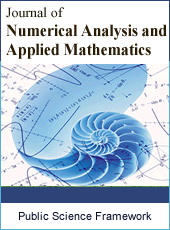Journal of Numerical Analysis and Applied Mathematics
Articles Information
Journal of Numerical Analysis and Applied Mathematics, Vol.1, No.1, Sep. 2016, Pub. Date: Jun. 20, 2016
Mathematical Modeling in Enhanced Index Tracking with Optimization Model
Pages: 1-5 Views: 2597 Downloads: 1232
[01]
Lam Weng Siew, Department of Physical and Mathematical Science, Faculty of Science, Universiti Tunku Abdul Rahman, Kampar Campus, Kampar, Perak, Malaysia; Centre for Mathematical Sciences, Centre for Business and Management, Universiti Tunku Abdul Rahman, Kampar Campus, Kampar, Perak, Malaysia.
[02]
Lam Weng Hoe, Department of Physical and Mathematical Science, Faculty of Science, Universiti Tunku Abdul Rahman, Kampar Campus, Kampar, Perak, Malaysia; Centre for Mathematical Sciences, Centre for Business and Management, Universiti Tunku Abdul Rahman, Kampar Campus, Kampar, Perak, Malaysia.
In portfolio management, the fund managers and investors desire to determine the optimal portfolio that can generate higher return at the minimum risk. Enhanced index tracking is a popular type of portfolio management which aims to construct the optimal portfolio in order to generate higher portfolio mean return than the benchmark index mean return. The fund managers can achieve this purpose by using the optimization model as a decision-making tool. The objective of this paper is to apply the optimization model with weighted approach in constructing the optimal portfolio to track the Technology Index in Malaysia. In this study, the data consists of weekly return of the companies from technology sector in Malaysia Main Market. The results of this study indicate that the optimal portfolio is able to outperform Technology Index by generating weekly excess mean return 0.3168% at minimum tracking error 1.8282%. The significance of this study is to identify and apply the optimization model with weighted approach as a strategic decision-making tool for the fund managers to track the benchmark Technology Index effectively in Malaysia stock market.
Weighted Model, Enhanced Index Tracking, Non-Linear Programming, Optimal Portfolio, Mean Return, Tracking Error
[01]
Best, M. J. (2010). Portfolio Optimization. United States, Chapman & Hall.
[02]
Roll, R. (1992). A mean variance analysis of tracking error. The Journal of Portfolio Management, 18: 13-22.
[03]
Beasley, J. E., Meade, N. and Chang, T. J. (2003). An evolutionary heuristics for the index tracking problem. European Journal of Operational Research, 148: 621-643.
[04]
Canakgoz, N. A. and Beasley, J. E. (2008). Mixed integer programming approaches for index tracking and enhanced indexation. European Journal of Operational Research, 196: 384-399.
[05]
Guastaroba, G. and Speranza, M. G. (2012). Kernel Search: An application to index tracking problem. European Journal of Operational Research, 217: 54-68.
[06]
Lam, W. S., Saiful, J. and Hamizun, I. (2015). The impact of different economic scenarios towards portfolio selection in enhanced index tracking problem. Advanced Science Letters, 21(5): 1285-1288.
[07]
Lam, W. S., Saiful, J. and Hamizun, I. (2015). An empirical comparison of different optimization models in enhanced index tracking problem. Advanced Science Letters, 21(5): 1278-1281.
[08]
Wu, L. C., Chou, S. C., Yang, C. C. and Ong, C. S. (2007). Enhanced Index Investing Based on Goal Programming. The Journal of Portfolio Management, 33: 49-56.
[09]
Wu, L. C. and Wu, L. H. (2012). Tracking a benchmark index – using a spreadsheet-based decision support system as the driver. Expert Systems, 30(1): 79-88.
[10]
Taha, H. A. (2011). Operations Research : An Introduction. 9th Edition, New Jersey, Prentice Hall.
[11]
Gitman, L. J., Joehnk, M. D. and Smart, L. J. (2011). Fundamentals of Investing. 11th Edition, Pearson.
[12]
Winston, W. L. (2004). Operations Research: Applications and Algorithms. 4th Edition, Belmon, Brooks/Cole.
[13]
Lam, W. S., Saiful, J. and Hamizun, I. (2014). Comparison between Two Stage Regression Model and Variance Model in Portfolio Optimization. Journal of Applied Science and Agriculture, 9(18): 36-40.
[14]
Lam, W. S., Saiful, J. and Hamizun, I. (2015). The impact of human behavior towards portfolio selection in Malaysia. Procedia of Social and Behavioral Sciences, 172: 674-678.
[15]
Meade, N. and Salkin, G. R. (1990). Developing and Maintaining an Equity Index Fund. Journal of Operation Research Society, 41(7): 599-607.
[16]
Reilly, F. K. and Brown, K. C. (2012). Investment Analysis and Portfolio Management. 10th Edition, Mason, South Western Cengage Learning.
[17]
Israelsen, C. L. (2005). A Refinement to the Sharpe Ratio and Information Ratio. Journal of Asset Management, 5(6): 423-427.

ISSN Print: Pending
ISSN Online: Pending
Current Issue:
Vol. 2, Issue 2, March Submit a Manuscript Join Editorial Board Join Reviewer Team
ISSN Online: Pending
Current Issue:
Vol. 2, Issue 2, March Submit a Manuscript Join Editorial Board Join Reviewer Team
| About This Journal |
| All Issues |
| Open Access |
| Indexing |
| Payment Information |
| Author Guidelines |
| Review Process |
| Publication Ethics |
| Editorial Board |
| Peer Reviewers |


